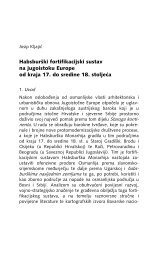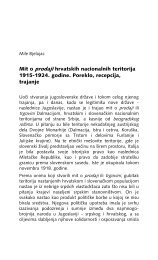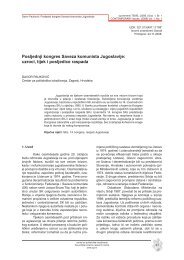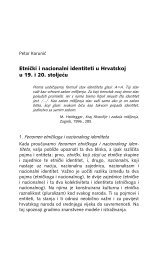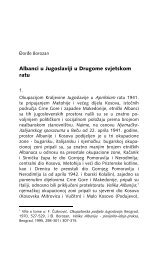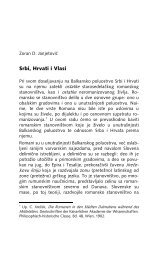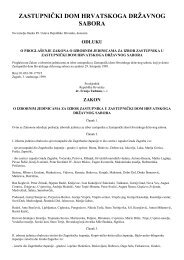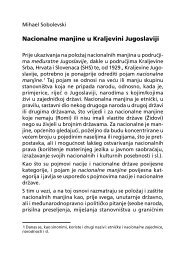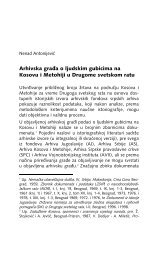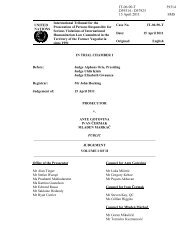ISSN 1847-2397 godište II broj 1 2009. | volume II number 1 2009
ISSN 1847-2397 godište II broj 1 2009. | volume II number 1 2009
ISSN 1847-2397 godište II broj 1 2009. | volume II number 1 2009
- No tags were found...
Create successful ePaper yourself
Turn your PDF publications into a flip-book with our unique Google optimized e-Paper software.
Maja Sahadžić: The Electoral System of Bosnia and Herzegovinasuvremene TEME, (<strong><strong>2009</strong>.</strong>) God. 2, Br. 1CONTEMPORARY issues, (<strong>2009</strong>) Vol. 2, No. 1An electoral system is a “unity of electoralprinciples and mechanisms of their achievementwhich is conducted as a part of the overallpolitical and constitutional system of a certainstate” (Đorđević, 1975: 697). For the purposesof this analysis, we will mention only the differencesbetween the proportional and the pluralityelectoral system and their influence on politicalparticipation. Proportional electoral systems areconsiderably more responsive to different politicalprogrammes; they enable representation ofsmaller political parties in representative bodies,which means taking a variety of interests of theelectorate into consideration. Majority systemsaspire to decrease the <strong>number</strong> of political parties,especially in the plurality systems. From theperspective of voters’ motivation, proportionalsystems are considered more motivating, becausethey make it possible for even some minorinterests to be represented, based on a certain<strong>number</strong> of votes (Šiber, 2004: 3-27). In the frameworkof proportional election systems, the meaningof the electoral threshold is also worth noting,i.e. the percentage of votes that is required forthe participation in the distribution of mandates.Logically, a high electoral threshold is explicitlydiscouraging, while a low one gives the smallerparties and their potential voters the chance toparticipate in sharing the “electoral cake” (Šiber,2004: 8). Generally speaking, all institutions, aswell as electoral systems, are designed and governedby laws and regulations, which are draftedby national or international actors. Nevertheless,this design can derive from different origins ofsocial and political change, being driven by accident,evolution or intention (Goodin, 1998: 24-30). Finally, previous experiences acknowledgethat effects of electoral systems are contingentlyconditioned and that they can be apprehendedonly by a historical-empirical analytic approach(Kasapović, 2002: 3-19).2. Historic BackgroundNot to be prejudiced and spacious, thisis how authors Belloni and Deane describe endingwar in Bosnia and Herzegovina: the BosnianWar lasted from April 1992 until November 1995,when a peace agreement was reached at Dayton,Ohio, after three weeks of intense negotiationsconducted under the aegis of the UnitedStates. The end of the war came about as aresult of three interrelated episodes. First, theNorth Atlantic Treaty Organization (NATO) conductedthe Operation “Deliberate Force” in September1995, effectively undermining the BosnianSerb war machine. Second, ethnic cleansingwas practically completed. With most (but notall) Bosnians living in ethnically defined areas,nationalists had achieved their goal of securingcontrol of territory by destroying the ethnic mixcharacterising Bosnia prior to the outbreak of theconflict. Third, Serbia and Croatia were ready toterminate their support for their ethnic cousinsin Bosnia. Serbia was desperate to obtain thelifting of the United Nations sanctions imposedearlier on. Croatia wanted to regain control of itseastern region of Slavonia taken by the Serbsin 1991, and gain international legitimacy for itsnewly acquired independent state. Both Serbianand Croatian leaders negotiated and signedthe peace at Dayton on behalf of their Bosniancounterparts. A massive international peace operationwas deployed in early 1996 to help theparties implement the agreement. Implementingthe Dayton Peace Agreement has been very difficult,and no clear exit strategy has yet emergedfor international organisations and humanitarianagencies in the country. The primary reason forthis is that the Dayton Peace Agreement wasnegotiated with the same ethnic leaders likelyto boycott its full implementation (Belloni andDeane, 2005: 219-243).Elections played a particularly importantrole in attempts to manage ethnic tensionsin plural societies such as Bosniaand Herzegovina. Debates about electoralsystems have traditionally revolvedaround the desirability of the major idealtypes. Majoritarian electoral systemsare designed to promote accountablesingle-party government, by awardingthe greatest representation to the twoleading parties with the most votes. Proportionalelectoral systems aim to generateinclusive and consensual powersharing,by producing parliaments thatreflect the vote shares of multiple parties.During the 1990s debates turnedincreasingly towards the pros and consof “combined” (or “mixed”) electoral systems,incorporating features of each ofthe major ideal types (Søberg Shugartand Wattenberg, 2001: chap 5).The Law for Protection of the Rights ofNational Minorities was adopted in 2003; however,its implementation still has not commenced.According to the Helsinki Committee for HumanRights in Bosnia and Herzegovina, the economicand social rights of the members of minoritycentar za politološka istraživanjathe political science research centrewww.cpi.hr62



